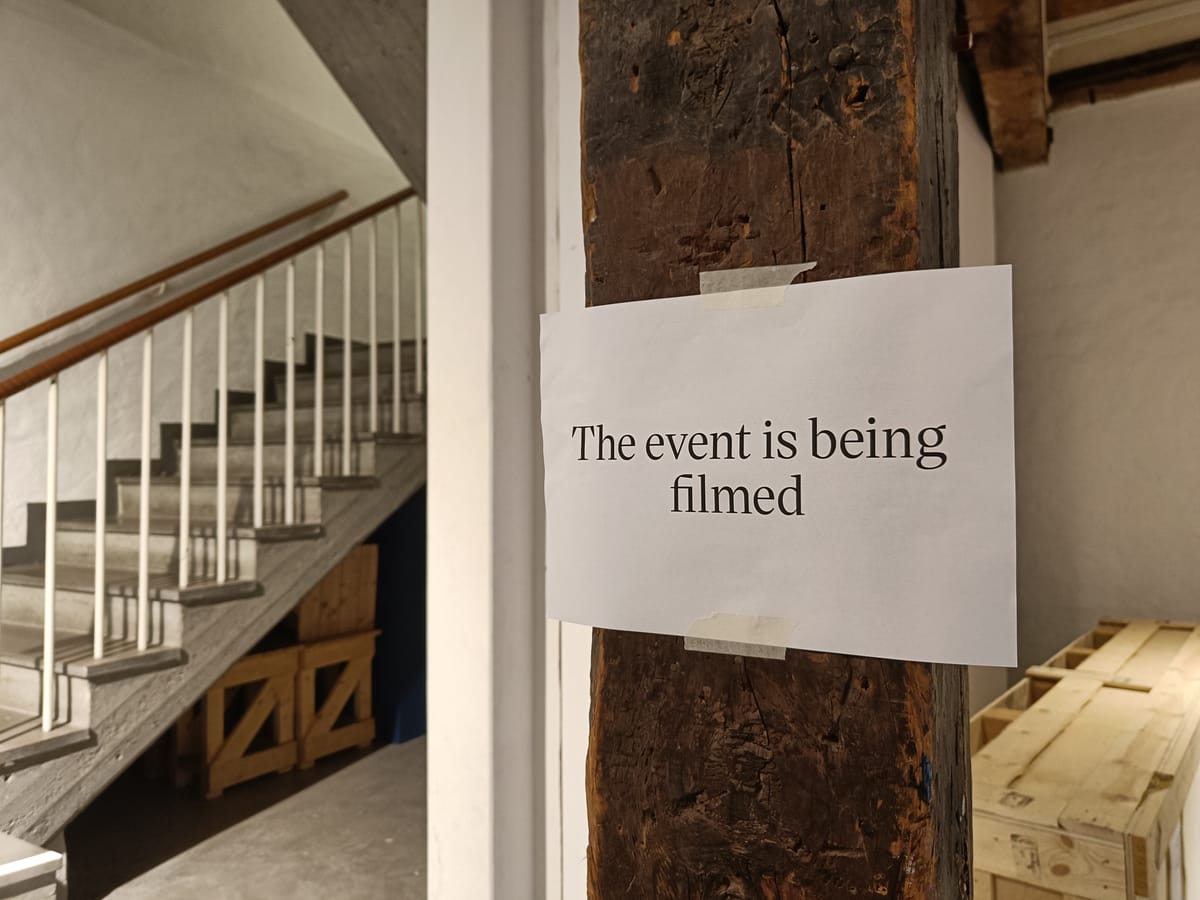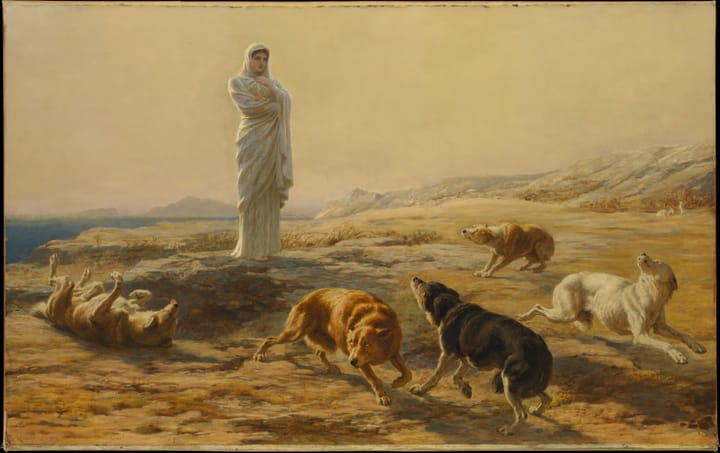week 05 / 2025
Past the old oak pillar and up the concrete stairs—that's where you'll find the WEEKNOTES, at least until the free beer runs out. This week, shells are haunted, and implausible worlds imagined with an uncanny thoroughness... oh, and a short story is published, too.

Step right up, step right up! Be the next to be the best, the one and only acid test WEEKNOTES at Worldbuilding Agency...
This week saw the launch of the Routledge Handbook of AI & Literature, in which I have a chapter. Those of you with the pertinent institutional privileges may therefore elect to read said chapter, A token effort? Reflections on the authoring of (science) fiction in an age of ‘artificial intelligence’, at Taylor & Francis Online.
(Even those of you with a research materials budget will likely, and rightly, balk at the obscene cost of the physical book. Those of you lacking institutional access privileges, but who retain nonetheless an interest in the particular angle on “AI” taken by the part of me that is an author of fiction, may prefer to make use of the most reliable yet underused loophole in the academic paywall: if you email the author and ask nicely, they’re at liberty to send you a copy.)
The chapter is a reflection on authorship in the shadow of LLMs in a general sense, but also in a specific sense: I was commissioned by the editors to write a piece of fiction, in order that I would have something specific to reflect upon. The original idea was that both story and reflection would be in the book—but I (as regular readers know all too well) am terminally verbose, and Routledge are sticklers for the (largely arbitrary, but traditional) ~7000 word limit for chapters.
The upshot of this is that the reflection constitutes the paywalled chapter of the book, while the story (titled “Inference”) is available for all and sundry to read, for free, on my canonical website. As I explain in the chapter, I decided to write a story which looks back on the LLM “moment” from a medium-term future in which the legacy of LLMs is not the only civilisational challenge in play, to say the least, but is nonetheless still a very serious one.
I hope you might find it an interesting diversion.
OK, that’s the self-promotion done for the week. What else have I been up to?
ticked off
- Nine hours doing STPLN stuff. (STPLN is providing a lively programme of lessons and workshops and hang-outs for its incubatees, and I’m electing to make the best of it by going to as many as I can reasonably attend without jeopardising my work for clients. I’m also signing up to commitments which should oblige me to get some substantive work done in terms of my visual art practice—because why the hell not?—as well as putting myself out there as a writer in the broadest sense of the term for collaborations with other members of the cohort. This translates to a not inconsiderable investment of time, but how else is one to advance one’s practice, eh?)
- Six and a half hours of admyn. (Various projects, various flavours. I remarked to a few people that it seems like the whole world got over the January slump last weekend, which resulted in a surge of emails and scheduling and plan-making; I’m just trying to stay on top of the wave, really.)
- Five hours on PROJECT PORTON. (Mostly meetings, some other bits.)
- Three hours on PROJECT HORNIMAN. (I wish I could have kept up last week’s close focus on this project, but that’s just not the way the schedule works.)
- Ten hours of undirected writing and reading, as always.
Oh, and I took Wednesday afternoon off, as well. If you have to endure the precarity and cashflow nightmares of being freelance, you might as well enjoy the upsides every once in a while, right?
(I thought watching Ghost in the Shell at the cinema that afternoon might be a pleasant indulgence… and it was! But it’s also the sort of movie where a lot of the crucial nuance is lost if you can’t read Swedish well or fast enough to follow the subtitles. The shooty-fighty-killy bits were easy to follow; the existential-cyborg-angsty bits, uh, rather less so.)
kinmaking
Samantha Culp spent well over two hours of Tuesday evening (which was her Tuesday morning) listening to me ramble around my thoughts’n’feelings about futures work, which surely qualifies her for some sort of award that celebrates the extraordinarily patient. In my defence, she may not have asked many questions, but the ones she asked were exactly the sort that encourage one to run off with the thread and see where it leads. (Gotta be honest, Sam: I’m glad it’s not me that has to transcribe all that!)
Thursday afternoon saw the launch of The Futures We Build, the latest project in which my good friends at Media Evolution have played an important facilitatory role. (No substantive contribution from yours truly this time, though I did proof-read and copy-edit the book.)
The celebratory shindig was on the top floor of the Form/Design Center in uptown Malmö, and the exhibition will be running until March—so if you’re passing through town, do go and take a look at four very different and provocative futures of the built environment sector. (If you’re not passing through town, there’s always the website and the downloadable version of the book!)
I’ve reached a point where I’ve been to enough of these things in Malmö that I recognise a bunch of people, and a bunch of people recognise me; sometimes it’s even the same people! However, these and other such events are a reminder that when a room gets crowded, I struggle to hear what’s being said, even by people stood close to me; legacy of a youth spent in close and unprotected proximity to amplified audio, innit? Probably high time I went to get my hearing tested…
reading
This week I have been returning to a set of books that I re-read every couple of years or so, because they stand for me as a sort of benchmark for the capacity of immersive worldbuilding in literature.
Now, to be clear, Brian Aldiss’s Helliconia trilogy is not without its technical flaws as a work of sf literature, as well as being very much “of its time” (i.e. the very late 1970s and early 80s) with regard to not only its underlying science but also its cultural politics. (Aldiss’s distinctly, ah, priapic personality is very present in the text, let’s say.)
But the science stuff actually makes it a great illustration of the notion of paleofutures: here’s a guy writing at the dawn of the 1980s (so, just within my own lifespan) who prides himself on the rigorous scientific foundations of his fiction, just casually positing human life on Earth might be going on thousands of years down the timeline from the present. That feels like a much more vexed proposition now than it did then, to say the least… though perhaps Aldiss might be counted as among the rare sf optimists of that era, at least in that regard.
But human life on Earth is literally a side-note in the Helliconia trilogy, which follows the centuries long “great year” of the eponymous planet, caught in a binary star system in which it orbits each of its two suns at very, very different distances. I will forbear from further explanation not for fear of spoilers, but because the whole thing is so big and intricate that it’s hard to know where to start, let alone to stop. The shapes of the foreground plots are for the most part familiar from family sagas and historical potboilers, both mythological and literary, and are little to write home about in and of themselves—but as I have argued elsewhere, the role of plot in worldbuilding-oriented artforms is to provide the reader with a guide-rope that will lead them through the fictional world.
The worldbuilding genres are not to the taste of every reader, of course—and even among those who appreciate them, there is much debate to be had about how thick, strong and well-braided that rope should be. Helliconia can very reasonably come in for critique in this regard, as well as for the obsolescence of its foundational assumptions. But when it comes to sheer scope and imaginal ambition, there are few examples of worldbuilding that even come close to it—and I think it deserves to be read for that reason alone.
a clipping
This one’s from a few week’s back, but worth returning to; it’s not good news, but all the more important for that.
In a piece discussing More and More and More by Jean-Baptiste Fressoz for the London Review of Books, Adam Tooze makes a point that myself and other academic colleagues have been trying to make for a couple of decades previously: that the history of successive energy “transitions”—which is held up by policymakers, businesses and much of academia as a template for the radical sociotechnical changes required to prevent drastic climate change—is basically fiction.
The ‘three energy transitions’ narrative isn’t just a simplification of a complex reality. It’s a story that progresses logically to a happy ending. And that raises a question. What if it isn’t a realistic account of economic or technological history? What if it is a fairy tale dressed up in a business suit, a PR story or, worse, a mirage, an ideological snare, a dangerously seductive illusion? That wouldn’t mean that the transition to green energy is impossible, just that it is unsupported by historical experience. Indeed, it runs counter to it.
It might seem counterintuitive to want this more widely known; after all, wouldn't it be better to have a motivating narrative in play that might encourage the process along? Well, no—because, as has been demonstrated, that narrative is very easily hijacked by not only the nefarious shysters of denial, but also the nihilistic peddlers of “solutions”.
If you'll excuse the crude analogy: if you really want to quit a drug that’s killing you, your odds of doing so will be greatly increased by preparing adequately for the true extent of the obstacles you will encounter, and by giving no quarter to those who would have you swap your existing addiction for another one which they just happen to profit from.
(Those who prefer their sobering analysis to have a more quantitative bent, and to be well-illustrated with graphs, may prefer to direct themselves to the companion / sibling essay that Tooze published on his own newsletter.)
OK, that’s all for now. Hope all's well with all of you.
This has been the Worldbuilding Agency weeknotes for Week 05 of 2025. Thanks for reading! If you've enjoyed them, it's free to subscribe. If you are already subscribed, please send to a friend who you think might also like it!





Comments ()